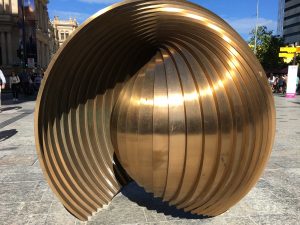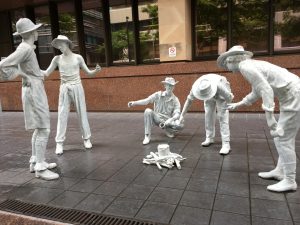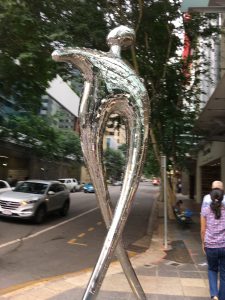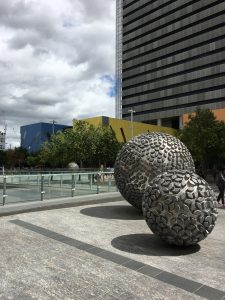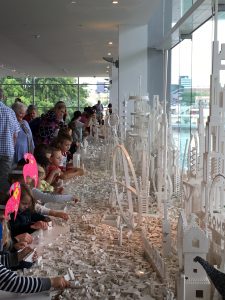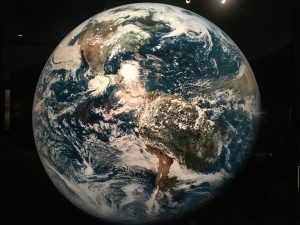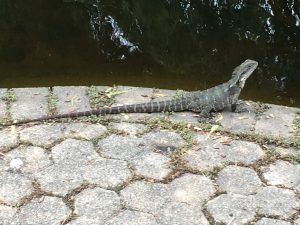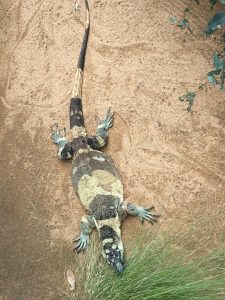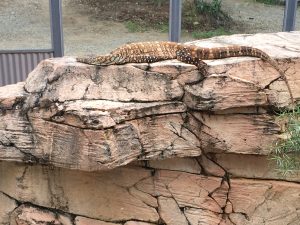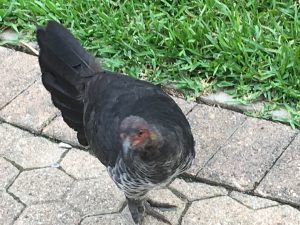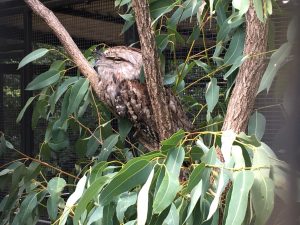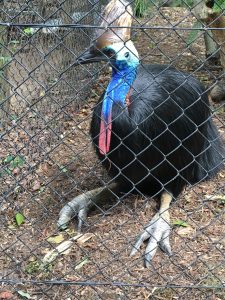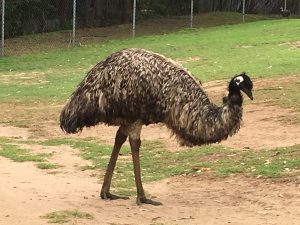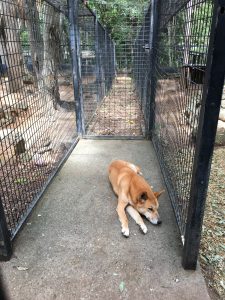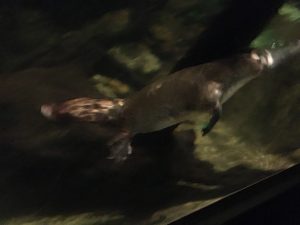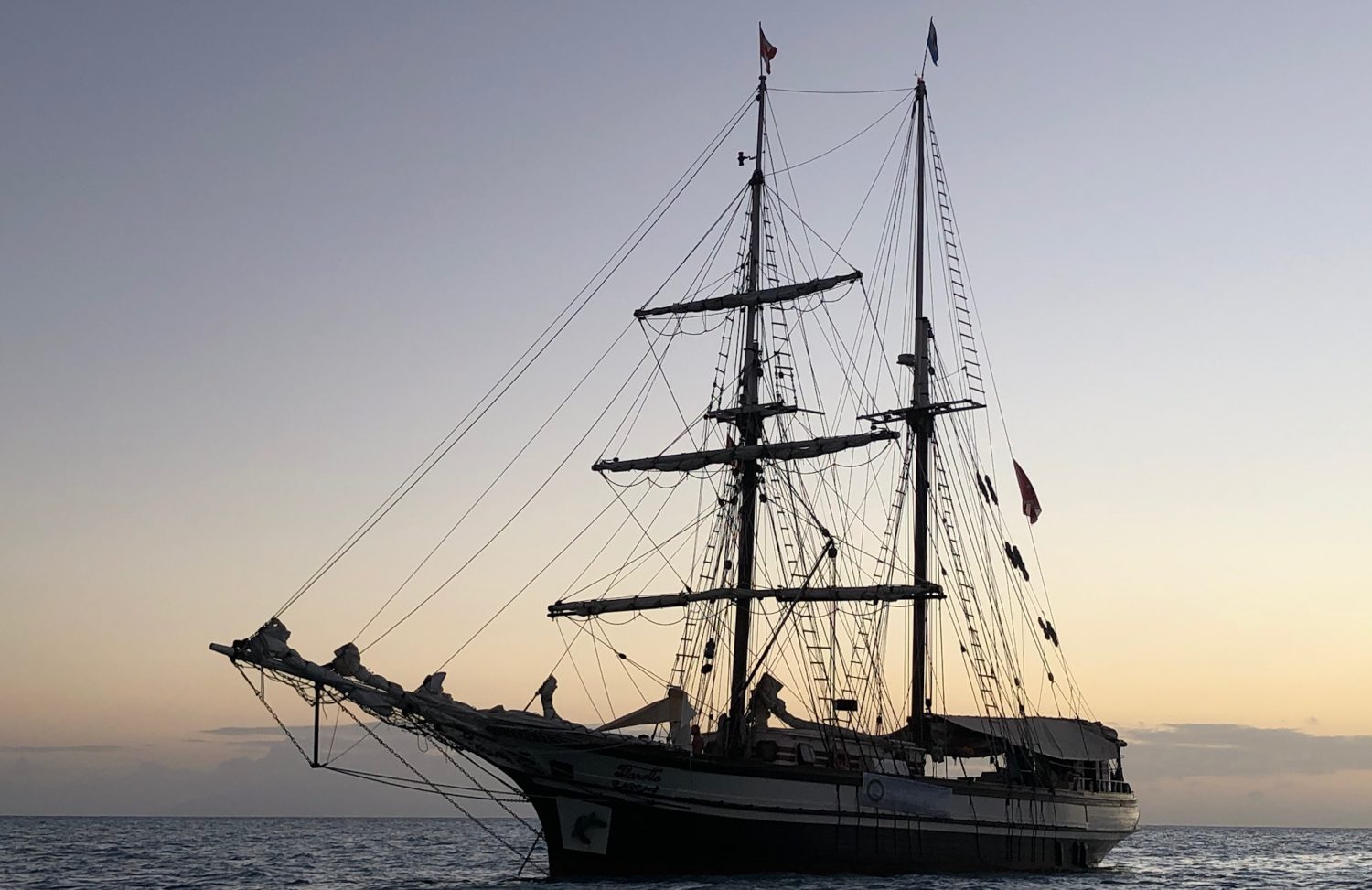A day without sunshine today, and some threats of showers… a perfect day for the museums! All located in the same area — the arts district — there’s the Queensland Museum, the Queensland Art Gallery and the Gallery of Modern Art all free and almost connected. So, I set off in that direction, and before reflecting on what’s there, I want to note the many pieces of art around the city itself. Random sculptures on pedestrian malls, and along the streets, and in plazas. Usually there’s a description of the work and the artist, generally saying that the piece was commissioned to make Brisbane beautiful and artsy. Well done I would say.
The Modern Art museum (GOMA) had several exhibits, all fairly avant-garde with contemporary artworks exploring light, space, architecture and the senses. Many were large scale, including one multicolored landscape of synthetic hair draped on the walls and across elevated spaces. It was like walking through the factory where Hasbro made the toys for Sully from Monsters, Inc. And the fur was evident on the floor throughout the rest of the galleries. Not having much of an appreciation for coats made of dead chickens, fish and frogs, or big clear spheres with threads creating shapes inside, I did appreciate the white Lego exhibit. Called “The Cubic Structural Evolution Project 2004”, the artist invites visitors to participate in tht construction of an every evolving cityscape, made from over 400,000 white Legos, challenging the notion that artwork must be made by just one person.
Then it was over to the Art Gallery, where an exhibit called “O’Keefe, Preston, Cossington Smith: Making Moderism” was on, and special enough for an entrance fee. The connection between these three female painters is that they came of age during the 1910’s and 1920’s, and each rejected artistic conventions of the day past and forged new ways to picturing the world. Preston and Cossington Smith are both Australian artists, and while I understood the intent of the exhibition, it felt a bit of a stretch to me. The styles and subjects didn’t appear to have much connection to me. I enjoyed the O’Keefe section, which included a biographical short film that was good.
Then over to the Museum, which drew me in because of an exhibit about the Large Hadron Collider, a transplant from the Science Museum in London. There was a cheesy film trying to reinforce how exciting it was that the team of 10,000 scientists from 40 countries had discovered the existence of the Higgs Boson Particle in 2012. Then you walked through re-creations of different labs with chalkboards and memos and notes explaining how the Collider works and why it’s important. The science is so beyond my comprehension — while I appreciated what was intended, I didn’t emerge any smarter for it. Except that it is an amazing feat for so many academic organizations and people around the world to collaborate at all.
The most amazing exhibit were photographs by Michael Benson who takes raw data from planetary science archives and processes it, editing, compositing and then ’tiling’ individual spacecraft frames, producing seamless large-format digital C-prints of landscapes currently beyond direct human experience. There were photos of Jupiter, Mars, Saturn, the Moon and of course Earth, all quite large and displayed in a dark gallery with the sounds from Brian Eno.
Now, a few other animals from yesterday’s visit, just because they are so different from those in NA. There were lace monitor lizards, also known as goannas, perentile lizards, Australia’s largest, the southern cassowary, the largest flightless bird known as a rainforest warrior, whose helmet is bony. The Australian brush turkey I saw in the Botanic Gardens, and chased me a bit, and the emu were in the paddock with the kangaroos. There were two dingos in a cage who didn’t look all that scary, and a couple of Tasmanian devils asleep in a log. The bird that looks like an owl but isn’t is a tawny frogmouth, and a blurry sighting of a platypus. When the first platypus specimen reached England in 1799 (it was long dead), it was regarded as a hoax, a “high frolic practised on the scientific community by some colonial prankster”. Experts of the day could not reconcile the fact that a duck-billed mammal with webbed feet and claws and a beaver-like tail could really exist. One zoologist, sure it was fraudulent, tried to remove the “duck’s bill” from the pelt; his scissor-marks can still be seen on the original, in London’s British Museum of Natural History. This one was busy chasing it’s potential dinner around the bottom of the tank, so I didn’t get a great view, but it was funny to watch.
I won’t be posting for a few days — headed to the Outback!
